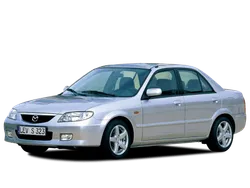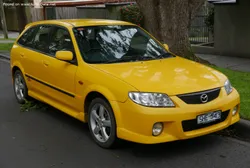

Mazda 323 Generation - 6 BJ Details
Explore the Mazda 323 Generation 6 BJ insights. Discover its specifications, features, and performance details that define this popular Mazda 323 generation in Portugal.
The Mazda 323, particularly its sixth generation (often referred to as the BJ), holds a special place in the hearts of many automotive enthusiasts. This model was produced between 1998 and 2003 and served as a compac...
Technical Specifications
Select Version
Dimensions
Engine
Driving
Others
History and Features
Mycarro AI
Apr 27, 2025
The Mazda 323, particularly its sixth generation (often referred to as the BJ), holds a special place in the hearts of many automotive enthusiasts. This model was produced between 1998 and 2003 and served as a compact car that was both versatile and practical. It was designed during a time when manufacturers were looking to create vehicles that targeted a broad range of consumers, balancing performance with fuel efficiency and user-friendliness.
Design and Features
The Mazda 323 BJ was designed with a sleek and modern aesthetic, showcasing a rounded body shape that was popular in late 1990s car design. The front featured a smooth grille and stylish headlights, contributing to its aerodynamic efficiency. Inside, the cabin was designed to be spacious and comfortable with quality materials that provided a pleasant driving environment. The dashboard was functional yet stylish, featuring a clear arrangement of controls and displays that emphasized usability.
In terms of dimensions, the 323 BJ offered ample passenger and cargo space, making it an excellent choice for families and individuals alike. The rear seats provided enough room for adult passengers, and the trunk had a surprising amount of storage space, which appealed to those needing practicality in their daily lives. The availability of various trims allowed buyers to customize their vehicles with preferred features, enhancing the overall appeal of the model.
Engine and Performance
Under the hood, the Mazda 323 BJ was available with a variety of engines, catering to different driving styles and needs. The engine options included both gasoline and diesel variants, with capacities ranging from 1.3 liters to 2.0 liters. The 1.6-liter engine, in particular, was known for its balance of power and fuel efficiency, producing adequate horsepower while maintaining economical fuel consumption.
The 323 BJ emphasized driving enjoyment, which was a hallmark of Mazda vehicles. With a well-tuned suspension system, it handled corners with agility and offered a surprisingly sporty experience for a compact car. The steering was responsive, providing drivers with good feedback and control. Overall, the driving dynamics were a significant selling point, appealing to both everyday drivers and those who appreciated a more engaging driving experience.
Safety and Reliability
Safety was an area of focus for the Mazda 323 BJ. Many models were equipped with features such as dual airbags, anti-lock braking systems (ABS), and reinforced body structures that contributed to its overall safety ratings. This attention to safety made the car a popular choice among families and those looking for a reliable vehicle.
Reliability was another strong suit of the 323 BJ. Mazda developed a reputation for manufacturing durable, long-lasting vehicles, and the 323 was no exception. Owners reported minimal issues over the lifespan of the vehicle, and many examples are still on the road today, testament to the car's longevity and resilience.
Market Presence and Legacy
Upon its release, the Mazda 323 BJ faced stiff competition from other compact cars in the market. However, it managed to carve out a niche for itself due to its appealing design, performance-oriented features, and competitive pricing. The model was particularly popular in regions like Europe and Asia, where compact cars were favored due to their practicality.
The sixth-generation Mazda 323 has a legacy that extends beyond its production years. Enthusiasts often reminisce about the car’s characteristics, highlighting its enjoyable driving experience and overall reliability. Today, the Mazda 323 BJ is remembered fondly by those who owned or experienced it, representing a period when compact cars could deliver both excitement and practicality.
Conclusion
In conclusion, the Mazda 323 Generation 6 (BJ) is a noteworthy model that successfully blended style, performance, and practicality. It represented Mazda’s commitment to producing vehicles that catered to a wide array of drivers, from daily commuters to families needing reliability without sacrificing driving enjoyment. As the years progress, the 323 BJ remains a cherished part of Mazda’s history and continues to be appreciated by car enthusiasts around the world.
